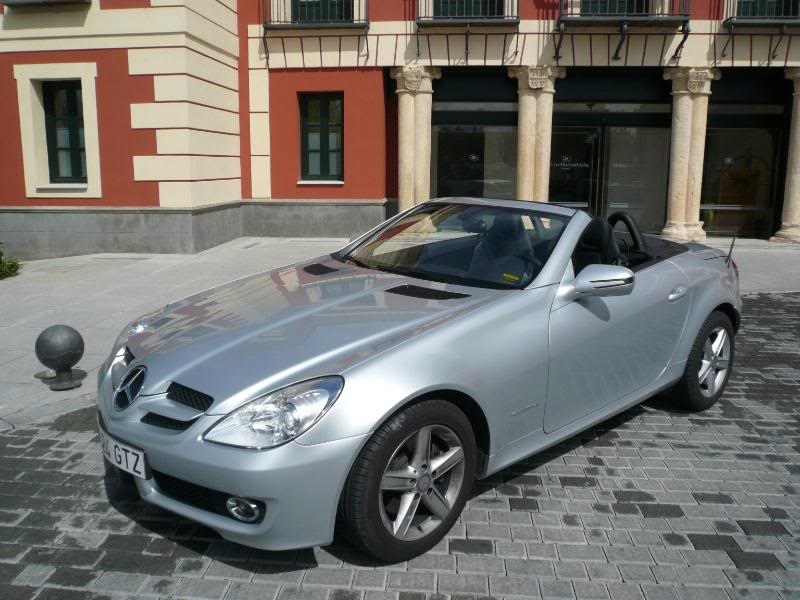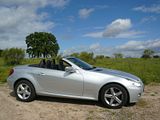
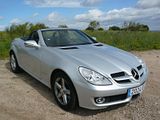
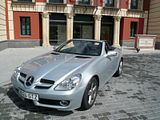


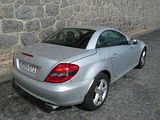
Fifteen years ago, one of the perceived downsides of a convertible, at least in the minds of some people, was that it came with a canvas roof, and was thus a potential target for vandals. Peugeot’s diminutive 206CC is widely credited with popularising the idea of a folding metal roof and solving this potential problem. Whilst there is some truth in this, the reality is that it was Mercedes’ first SLK that came to market a couple of years previously which actually introduced the buying public to the idea that you could have both the advantages of open air motoring and the relative security of a metal top. The first generation SLK cars (the R170 models) were well enough received and certainly sold in significant volume, but they never truly found favour with the press who thought that they had an element of style over substance, only addressed late in the model’s life when V6 engined cars joined the range. The second generation model, codenamed R171, which appeared in 2004 was destined to change all that, with its McLaren SLR aping looks and vastly superior dynamics. It has sold well, even with the advent of significantly stronger competition from BMW’s Z4 model and Audi’s TT Roadster as well as less obvious rivals such as Nissan’s 350Z, and even the short-lived Chrysler Crossfire which was in fact based on the underpinnings of the previous SLK. Enthusiasts inevitably favoured the six cylinder models and the rather lively AMG badged cars, but part of the appeal of this small two seater sports car lay in the affordable entry level SLK200K, whose entry price in the UK starts at not a lot over £30,000. Whilst that may no longer be quite the bargain that it used to be, it still represents a reasonable deal for the enthusiast. With my latest test, I wanted to find out just what this Mercedes has to offer.

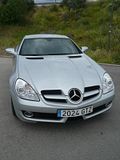

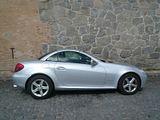 Whilst you could own and drive an SLK as your sole car, I suspect that not that large a percentage of its owners do so. For a start, it is small. At just over 160″ long, and a strict two seater, this is a little car by the standards of modern cars. I would guess that the SLK is just as likely to be bought as much for its static appeal as its dynamic prowess, and therefore is going to have to hit the mark in both regards. I happen to like the looks of this model. The front end is reminiscent of the SLR, but with its own unique style, and the rather chopped off rear end is quite neatly presented. The whole car does definitely shout “Mercedes” at you, yet it is distinctive and unlikely to be mistaken for any other model. Many metal roof cabrios look rather gawky with the roof closed, but I think the SLK looks just as good with the roof up or down. As a static object, the SLK is unlikely to disappoint. But that is not going to be sufficient unless it is good to drive as well.
Whilst you could own and drive an SLK as your sole car, I suspect that not that large a percentage of its owners do so. For a start, it is small. At just over 160″ long, and a strict two seater, this is a little car by the standards of modern cars. I would guess that the SLK is just as likely to be bought as much for its static appeal as its dynamic prowess, and therefore is going to have to hit the mark in both regards. I happen to like the looks of this model. The front end is reminiscent of the SLR, but with its own unique style, and the rather chopped off rear end is quite neatly presented. The whole car does definitely shout “Mercedes” at you, yet it is distinctive and unlikely to be mistaken for any other model. Many metal roof cabrios look rather gawky with the roof closed, but I think the SLK looks just as good with the roof up or down. As a static object, the SLK is unlikely to disappoint. But that is not going to be sufficient unless it is good to drive as well. 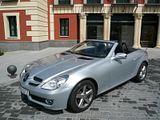
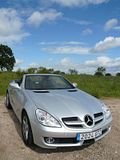
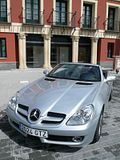 No longer can you be sure of the actual engine size of a Mercedes from its model designation. Despite what the badge on this car might lead to you guess, it is in fact powered by an 1800cc engine, which is boosted by Mercedes’ Kompressor supercharger technology, so it boasts 184 bhp. This represents an increase of 21 bhp over the initial SLK200 models (those made from 2004 – 2007), but even so is not spectacular for what amounts to quite a small sports car these days, but in reality it is ample to make the SLK feel moderately brisk. What surprised me was the noise that emanates from this powerplant. It is hard to describe as it is not quite like any other car I have driven, even Mercedes’ own C Class when fitted with the same engine. As a four cylinder engine, you certainly do not get the refined hum of a six cylinder motor, but you do get something with its own distinctive sound at idle, which is not that unpleasant, and feels reasonably smooth. Rev the engine harder, as you undoubtedly will, a treatment to which it does not appear to object, and the noise does change somewhat with a faint trace of the distinctive whine of the supercharger. The SLK200 is never going to win prizes for speed, but nor is it going to embarrass you for sloth. The car does need to be worked quite hard to make reasonable progress, though. Entry level models, such as the test car, come with a six speed manual gearbox. Usually, the words Mercedes and manual gears are things you should avoid putting together, but there were no issues with this set up. The change is positive enough, with just sufficient resistance in the ‘box for you to be clear what you were doing, and a short travel between fifth and sixth gears. I did find it possible to get fifth when changing up from second, but the torque characteristics of the engine meant that although I could immediately hear and feel that I had got the unintended gear, it was not exactly a problem. What was more of a problem was the noise. Thanks to some unseasonably disappointing weather during the test, I spent most of my time with the SLK driving with the roof up. Two sources of noise were rather too evident: wind noise and road roar. Frankly neither were really what I wanted to hear when cruising on the autopista. Drive with the roof lowered and the whole experience seemed to be rather more as I expected and hoped for. I had to conclude that although the roof did an excellent job at convincing me I was in a coupe, this a car to use with roof lowered whenever possible. I found no other issues with the other dynamics. The steering is well weighted and positive, and the handling seemed to be neat, not that it was tested much more than on the autopista and other main roads between Madrid and Toledo. The brakes were good, with plenty of feel and the pull up central lever was well appreciated (and unusual in a Mercedes) given the manual transmission. Perhaps slightly surprisingly, given the short wheelbase, I thought the SLK rode well, and it proved to be a comfortable cruiser. Visibility is good, even with the roof up, when the generous glass area meant that the view over the shoulder was excellent, and the field of vision in the door mirrors just helped further. With the roof down, you really could see right around you.
No longer can you be sure of the actual engine size of a Mercedes from its model designation. Despite what the badge on this car might lead to you guess, it is in fact powered by an 1800cc engine, which is boosted by Mercedes’ Kompressor supercharger technology, so it boasts 184 bhp. This represents an increase of 21 bhp over the initial SLK200 models (those made from 2004 – 2007), but even so is not spectacular for what amounts to quite a small sports car these days, but in reality it is ample to make the SLK feel moderately brisk. What surprised me was the noise that emanates from this powerplant. It is hard to describe as it is not quite like any other car I have driven, even Mercedes’ own C Class when fitted with the same engine. As a four cylinder engine, you certainly do not get the refined hum of a six cylinder motor, but you do get something with its own distinctive sound at idle, which is not that unpleasant, and feels reasonably smooth. Rev the engine harder, as you undoubtedly will, a treatment to which it does not appear to object, and the noise does change somewhat with a faint trace of the distinctive whine of the supercharger. The SLK200 is never going to win prizes for speed, but nor is it going to embarrass you for sloth. The car does need to be worked quite hard to make reasonable progress, though. Entry level models, such as the test car, come with a six speed manual gearbox. Usually, the words Mercedes and manual gears are things you should avoid putting together, but there were no issues with this set up. The change is positive enough, with just sufficient resistance in the ‘box for you to be clear what you were doing, and a short travel between fifth and sixth gears. I did find it possible to get fifth when changing up from second, but the torque characteristics of the engine meant that although I could immediately hear and feel that I had got the unintended gear, it was not exactly a problem. What was more of a problem was the noise. Thanks to some unseasonably disappointing weather during the test, I spent most of my time with the SLK driving with the roof up. Two sources of noise were rather too evident: wind noise and road roar. Frankly neither were really what I wanted to hear when cruising on the autopista. Drive with the roof lowered and the whole experience seemed to be rather more as I expected and hoped for. I had to conclude that although the roof did an excellent job at convincing me I was in a coupe, this a car to use with roof lowered whenever possible. I found no other issues with the other dynamics. The steering is well weighted and positive, and the handling seemed to be neat, not that it was tested much more than on the autopista and other main roads between Madrid and Toledo. The brakes were good, with plenty of feel and the pull up central lever was well appreciated (and unusual in a Mercedes) given the manual transmission. Perhaps slightly surprisingly, given the short wheelbase, I thought the SLK rode well, and it proved to be a comfortable cruiser. Visibility is good, even with the roof up, when the generous glass area meant that the view over the shoulder was excellent, and the field of vision in the door mirrors just helped further. With the roof down, you really could see right around you.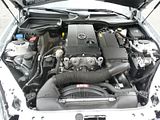
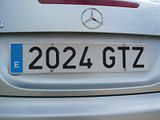 There is no mistaking the fact that you are in a Mercedes when you look inside the passenger compartment, with a marque characteristic style to the dashboard and interior trim. That is not universally good, of course. There is a large column stalk on the left, mounted rather low, which as well as handling the indicators operates the wipers, by twisting the end of the stalk. I found it all too easy, as I usually do with any Mercedes initially, to go for the higher mounted thinner stalk that operates the cruise control, and then when I did get the right wand to use, the wiper function (much needed given the weather) was too fiddly. There is a thin right hand column stalk but it is used for various other ancilliary functions for the stereo system, in conjunction with the wheel mounted controls. The main instruments are presented under a single cowled binnacle and are very clear, as ever with a Mercedes. There are just two, with smaller gauges for fuel level and water temperature set in the bottom of the speedometer and rev counter. Between the two is an area for the odometer, other trip computer functions and warning lights. The light switch is low down to the left of the wheel, and could do with a warning light in the main binnacle to tell you the lights are illuminated. The centre of the dash contains the air conditioning controls (automated climate control is an extra on this model) and the standard issue Mercedes sound system. This can be upgraded into a more sophisticated system should you so desire. I did struggle to get the driving position to my liking, as the front seat would not adjust quite far enough forward (surprisingly), and in an ideal world, I would have set the column a couple of inches higher as well. The test car had the optional leather seat coverings which I would imagine are fitted to virtually all SLK models, but at extra cost. After enduring a number of years of justified criticism for the build quality of its cars, this one felt very solid and durable, and although the test car had only covered 6000 km, it gave the impression that it would last well and for a long time.
There is no mistaking the fact that you are in a Mercedes when you look inside the passenger compartment, with a marque characteristic style to the dashboard and interior trim. That is not universally good, of course. There is a large column stalk on the left, mounted rather low, which as well as handling the indicators operates the wipers, by twisting the end of the stalk. I found it all too easy, as I usually do with any Mercedes initially, to go for the higher mounted thinner stalk that operates the cruise control, and then when I did get the right wand to use, the wiper function (much needed given the weather) was too fiddly. There is a thin right hand column stalk but it is used for various other ancilliary functions for the stereo system, in conjunction with the wheel mounted controls. The main instruments are presented under a single cowled binnacle and are very clear, as ever with a Mercedes. There are just two, with smaller gauges for fuel level and water temperature set in the bottom of the speedometer and rev counter. Between the two is an area for the odometer, other trip computer functions and warning lights. The light switch is low down to the left of the wheel, and could do with a warning light in the main binnacle to tell you the lights are illuminated. The centre of the dash contains the air conditioning controls (automated climate control is an extra on this model) and the standard issue Mercedes sound system. This can be upgraded into a more sophisticated system should you so desire. I did struggle to get the driving position to my liking, as the front seat would not adjust quite far enough forward (surprisingly), and in an ideal world, I would have set the column a couple of inches higher as well. The test car had the optional leather seat coverings which I would imagine are fitted to virtually all SLK models, but at extra cost. After enduring a number of years of justified criticism for the build quality of its cars, this one felt very solid and durable, and although the test car had only covered 6000 km, it gave the impression that it would last well and for a long time. 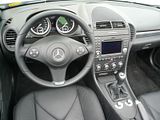
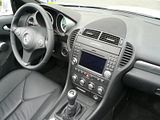 The SLK is very clearly a two seater. There is only any trace of space behind the seats if they are set well forward, in which case you might be able to squeeze a few small items of luggage in between the seat backrest and the rear bulkhead. Otherwise, you had better pack light. The boot is not exactly commodious. As with many of the current generation of metal-roofed cabrios, there is a divider in the boot, which must be in place when the roof is raised and lowered. If you are confined to the space underneath it, as you will be when the roof is down, there is not much room at all. Just sufficient for my large-ish sports bag of clothes and PC bag, with room to tuck a few bits and pieces around the side. If you could slide this divider up and out of the way, you would be able to get in at least twice as much luggage, but that would still not amount to very much. Drivers of the SLK would have to learn to pack light. In the cabin you will find some meagre and rather difficult to access door pockets, a small glove box, and a cubby on the rear bulkhead, so you are not exactly going to be able to make up for the small boot with stuff crammed into the passenger compartment.
The SLK is very clearly a two seater. There is only any trace of space behind the seats if they are set well forward, in which case you might be able to squeeze a few small items of luggage in between the seat backrest and the rear bulkhead. Otherwise, you had better pack light. The boot is not exactly commodious. As with many of the current generation of metal-roofed cabrios, there is a divider in the boot, which must be in place when the roof is raised and lowered. If you are confined to the space underneath it, as you will be when the roof is down, there is not much room at all. Just sufficient for my large-ish sports bag of clothes and PC bag, with room to tuck a few bits and pieces around the side. If you could slide this divider up and out of the way, you would be able to get in at least twice as much luggage, but that would still not amount to very much. Drivers of the SLK would have to learn to pack light. In the cabin you will find some meagre and rather difficult to access door pockets, a small glove box, and a cubby on the rear bulkhead, so you are not exactly going to be able to make up for the small boot with stuff crammed into the passenger compartment.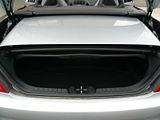
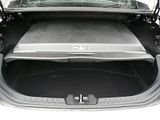
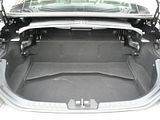 Despite the rather inclement weather, I did get to sample the SLK with the roof down, and I did of course test out the operation of the folding roof. It could not be simpler. As long as the divider is in the correct place in the boot, with the ignition on, simply press the switch on the centre console between the seats and the whole process completes in 20 seconds or so. You have no clips to release, and you do not even need to play with the settings for the side windows. Closing the roof is exactly the same process in reverse. You can even do it with the engine running.
Despite the rather inclement weather, I did get to sample the SLK with the roof down, and I did of course test out the operation of the folding roof. It could not be simpler. As long as the divider is in the correct place in the boot, with the ignition on, simply press the switch on the centre console between the seats and the whole process completes in 20 seconds or so. You have no clips to release, and you do not even need to play with the settings for the side windows. Closing the roof is exactly the same process in reverse. You can even do it with the engine running.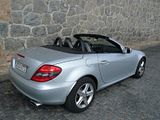
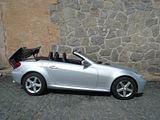
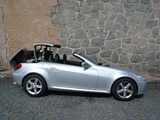
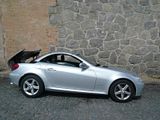
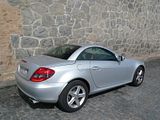 This was never originally even going to be a test of an SLK. Hertz Espana had allocated almost new BMW Z4 to me, in accordance with my booking. It was an entry level Z4 sdrive23i, which is most closely comparable to this car. Sadly, my experience of that car lasted precisely 9 km, as within 2 km of leaving Barajas Airport, I spotted that the tyre pressure warning light was illuminated, and thought it prudent to return. Hertz did not have another Z4, so gave me the SLK. For reasons I do not understand, they place the BMW in their “Fun” collection, and a weekend’s rental was priced at barely more than the cost of a Focus, whereas the Mercedes is in their “Prestige” collection and was priced nearly three times higher. So, whilst it was disappointing not to sample the BMW, I was happy enough that I got the more expensive rental for the price of the cheaper one. As just about everything else went wrong on the weekend’s excursion, I will – once the threat of strikes, and volcanic ash has rescinded – be back to Madrid, and will try again to get a longer drive of the Z4. Meanwhile, I can report that the SLK is not without its appeal, and I would actually be far from disappointed if I get to sample this car again.
This was never originally even going to be a test of an SLK. Hertz Espana had allocated almost new BMW Z4 to me, in accordance with my booking. It was an entry level Z4 sdrive23i, which is most closely comparable to this car. Sadly, my experience of that car lasted precisely 9 km, as within 2 km of leaving Barajas Airport, I spotted that the tyre pressure warning light was illuminated, and thought it prudent to return. Hertz did not have another Z4, so gave me the SLK. For reasons I do not understand, they place the BMW in their “Fun” collection, and a weekend’s rental was priced at barely more than the cost of a Focus, whereas the Mercedes is in their “Prestige” collection and was priced nearly three times higher. So, whilst it was disappointing not to sample the BMW, I was happy enough that I got the more expensive rental for the price of the cheaper one. As just about everything else went wrong on the weekend’s excursion, I will – once the threat of strikes, and volcanic ash has rescinded – be back to Madrid, and will try again to get a longer drive of the Z4. Meanwhile, I can report that the SLK is not without its appeal, and I would actually be far from disappointed if I get to sample this car again.2010-05-10 20:29:44

























